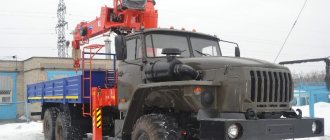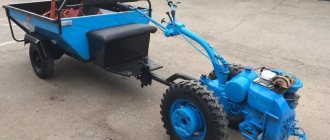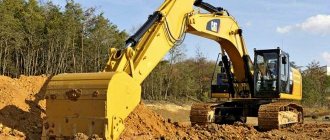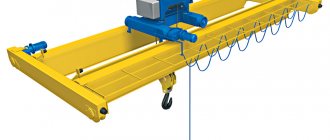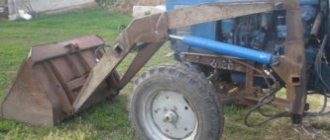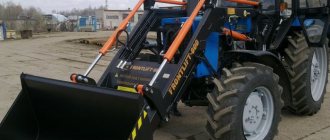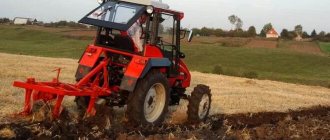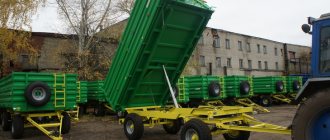A grab loader is a special attachment that can be installed on the base of a truck or tractor. Using this system, mining and other materials are loaded. As the main working body, grab loaders use special mechanical jaws that can close and open as needed. The machines are unique in that they can load almost any material, regardless of their density and type; in particular, grabs are used in logging operations.
Purpose and technical characteristics
The DL Agro crane is intended for use in farms and agricultural enterprises both in the field for loading and unloading seed, fertilizers and other bulk goods transported in Big Bag bags, and when performing various types of repair and construction work, as well as for transporting goods in conjunction with a tractor trailer 2PTS-4 and analogues. The DL Agro hydraulic manipulator can be used for repairing agricultural machinery and various equipment.
Main advantages
Application
Structurally designed for mounting on tractors MTZ, YuMZ, KhTZ, as well as their imported analogues. Connects to the standard hydraulic system of the tractor. Does not require registration with technical supervision authorities.
Modernization
Based on the results of trial operation, the following changes and modifications were made to the basic model of the crane:
- outriggers were replaced with hydraulic ones;
- a 5-section hydraulic distributor is installed, with the help of which the crane-manipulator is fully controlled: alternate control of hydraulic outriggers, raising/lowering the boom, extending the boom, rotating the boom on the axis. At the request of the client, the control of the crane can be transferred to the cabin or behind the tractor cabin;
- The bearing unit of the boom rotation axis has been improved, which is now a closed type with two grease fittings for lubrication;
- a number of changes were made to the design of the loader crane, which made it possible to move the tipping point closer to the tractor;
- the rear hitch has been strengthened, which makes it possible to tow larger trailers;
- throttles are installed for manual adjustment of the boom rotation speed;
- A hydraulic lock is installed on each of the hydraulic cylinders of the manipulator crane to automatically lock the working fluid in the cavities of the cylinders in order to fix them in specified positions under load.
Carrying out repair work
The diesel tractor T-16 grab loader is used in many areas and is capable of working in tandem with other equipment, in particular with flatbed trucks or dump trucks up to 20 tons. Domestic consumers, as a rule, use this equipment at full capacity, which affects its technical condition. Despite the fact that the loader unit has long been out of production, there are a lot of spare parts for repairs. Repair work requires some knowledge and special tools, with the help of which it is possible to carry out repairs and installation of individual units. The equipment, due to its simplicity of design and simple design of power units, can be serviced at almost any technical station.
Design and principle of operation of the hitch
The hydraulic linkage system on the tractor is designed not only for coupling with additional units, but also for transmitting power from the engine to the equipment. It is also used to raise and lower a plow or other devices back into the ground. Therefore, the linkage is directly connected to the hydraulic system and drive axle of the tractor.
Layout diagram of the first tier of the canopy
Types of attachments on MTZ
According to the type of placement of the mounted mechanism relative to the agricultural machine, four types of mechanisms are distinguished:
- Universal rear linkage. With its help, the machine is aggregated with most excavator equipment, such as mowers, seeders, dozers and street cleaning devices.
- Front (front) linkage. It has the same design as the mechanism installed on the rear of the tractor. The front linkage is designed to couple with headers, front grader buckets, mowers, sprayers and snow removal machines.
- Side hinged mechanism. Used for working with brush cutting equipment and single-bar mowers. The connection is made using universal couplings that come with the machine.
- Individual hanging systems. This mechanism is used when universal attachments are not suitable. For example, if equipment originally designed for other tractor models will be mounted.
What does the MTZ rear linkage consist of?
The design of the MTZ 82 linkage is quite simple. The device consists of:
- two horizontal rods connected by a metal rod;
- From above, braces are attached to the rods using special forks;
- with the help of a lifting lever, the braces are fixed on the shaft of the lifting lever;
- The lifting lever is fixed on one side to the hydraulic cylinder rod, and the other side is connected to the upper central rod, which ensures the transmission of power to the units.
Some mounting options on the MTZ 82 are equipped with longitudinal rods with extensions. The extensions are connected to the rear axle by means of hinges. Attachments for the MTZ tractor are fixed on hinges at the end of the longitudinal links of the device and on the hinge of the central link. This is called a three-point hitch.
Rear linkage equipment for MTZ 82
A two-point hitch option is also available. It is used when using plows that move along a curved line in the soil. Accordingly, there is no need for rigid fixation of the device. This means that the central thrust is not used.
When the hydraulic system is activated, the cylinder rod retracts. It acts on the swing arm, and through it on the lift arm shaft. This manipulation uses the hitch braces, which lift the rods upward, and with them the connected unit. To prevent the rods from moving in the horizontal plane during lifting, they are tensioned with chains that are attached to a steel rod connecting the rods to each other.
Units connected to MTZ tractors by means of a hitch usually operate on uneven areas of the field. To ensure stable operation of the devices, in this case the range of vertical-transverse movement of the connected machine relative to the tractor frame increases. This is done by connecting the braces with the rods through the grooves of the forks. The forks of the braces are fixed on the rods with the hole forward, so that the braces move freely inside the grooves, and the fingers at the end of the rods do not interfere with them.
Specifications
The following table clearly shows the main block of technical characteristics of the T 16 tractor chassis:
| Parameter | U measurement | Magnitude |
| width (on track) | mm | 1550-2000 |
| length | mm | 3820 |
| height | mm | 2600 |
| weight | kg | 1685 |
| traction class | — | 0,6 |
| engine power | hp | 16 |
| maximum possible speed | km/h | 17,6 |
| fuel consumption | g/kWh | 272 |
Let us dwell in more detail on some of the features of the T-16.
Device
The T-16 tractor has a number of features that distinguish it from other specialized machines of this type:
- The main external difference of the T 16 is the original location of the entire transmission mechanism and the engine itself behind the operator’s cab. In front, attachments or a loading platform can be placed. This design of the machine allows for the most complete overview and improved maneuverability.
- The gearbox of T-16 tractors provides them with 7 forward gears and 1 reverse gear.
- The wheels of the T-16 are of different sizes, with the ability to change the track width for both pairs of wheels and with a shift in the center of gravity in the rear axle. Their device allows you to expand the scope of use of the tractor to detailed processing of agricultural crops (weeding between rows, etc.), and also improves its cross-country ability by increasing the quality of road grip.
- The T-16 engine consists of the following components:
- Starter;
- gas distribution circuit;
- crank mechanism;
- lubrication and cooling system;
- The tractor is equipped with dry band brakes with a mechanical drive.
- To install the equipment, special platforms and holes are provided on the tubular frame.
- To effectively control the equipment, a hydraulic system with two power cylinders is provided.
Engine
This self-propelled chassis is equipped with a D-16 two-cylinder diesel engine with a 7-speed gearbox and several power take-off shafts (usually main and synchronous), the nominal value of which reaches 13.4 kW. The crankshaft rotation speed is 1750 rpm, and the piston stroke is 12 cm. In this case, the power transmission from the engine to the working parts of the machine (transmission) is mechanical, with a permanently closed clutch system and a single-disc spur gear gearbox. This system provides high efficiency, operational reliability and ease of operation.
ATTENTION! The engine used for the T-16 is air-cooled.
The advantage of this fact is the ability to work at low temperatures without the risk of freezing of coolants, but the disadvantage is the need to frequently flush the air valves.
Stable operation of the special vehicle is also ensured by:
- A set of necessary electrical equipment, including a starter, relay and battery with a generator;
- Additional equipment with a hydraulic system, including a pump, distributor, power cylinder.
Attachments
Attachments are an indispensable part of production processes in which the tractor chassis takes part. Thanks to it, the functions and capabilities of the machine can be expanded to the maximum, making it universal.
It can be:
- Plows, seeders and cultivators;
- Potato processors – planters and diggers;
- Excavator equipment;
- Mechanisms for making hay (mowers, etc.).
With their help, the T-16 will be able to dig and transport soil, remove snow and debris, work on a construction site, develop farmland and much more. Attachments are usually purchased separately from the tractor depending on the need - for utility, construction, transportation or agricultural needs.
T-16 tractor with bucket
Do it yourself - tractor.
An open project is presented in which enthusiastic farmers have formed a collection of specifications and drawings distributed under free licenses, allowing them to assemble various agricultural machines with their own hands, from tractors and combines, to irrigation systems and electric generators. The ultimate goal of the project is to create a complete set of open specifications on the basis of which it is possible to build a farm that is completely self-sufficient with low initial costs. And what? - very relevant.
Topic author: Vladimir
Good people, send me the drawings on how to make a kun on T16 with your own hands))) video is possible!
Vitalik (Tamra) Read here https://fermer.ru/forum/samodelnaya-selskokhozyaistven..
Zulfar (Tameka)
Zulfar Zulfar, but there is no such drawing for the self-loader
I'll post it as soon as I draw it
Zulfar Zulfar, I'll wait, thank you
Thanks a lot
Do-it-yourself loader for the rear linkage of a tractor
For many owners of private farms (personal subsidiary plots), a loader on the rear linkage of a tractor is very, very interesting. Why? Because purchasing a highly specialized unit (loader) is too expensive, and a thrifty owner is unlikely to spend a lot of money on it. It is much easier to modernize an existing tractor on the farm.
What is needed for this? First, metal (you will need a lot of it). Secondly, a special tool. Thirdly, straight arms.
Options for purchasing T-16
You can buy a T-16 loader inexpensively on the secondary market, where you can often find various offers from private entrepreneurs. Since the loader stopped being produced back in 1995, it can only be purchased aftermarket. On the domestic market of used units and machines, there are quite a lot of different modifications, but most vehicles are in unsatisfactory technical condition and require investment. Some companies are engaged in the restoration of special equipment and offer the buyer to purchase a T-16 with a loader in installments or as a package deal. These offers are popular and quite beneficial for both parties. Many companies offer loans on favorable terms. Since the tractor has a low cost, most clients agree to the loan terms and purchase this equipment.
Nowadays everyone has switched to balers.
The PRF-145 baler is used on the farm for pressing hay and straw, followed by wrapping it with twine thread and dumping the finished roll or bale on the ground. Then there is loading and transportation to the place of consumption.
Thanks to this technology, that the hay is compressed in rolls (bales), it has become more convenient for the tractor driver to load. (and more weight can be removed at one time). For this, a homemade universal KUN is enough. In addition, the process of preparing feed (hay) itself has become faster, less costly and more economical.
You might like these videos:
✅Homemade mini coon with a long arrow
✅We load mini coons with our own hands and carry rolls
✅UNIVERSAL STOGOVOZ how to make it yourself
✅Yes, we are tractor drivers!!!
Modifications
The purely basic model T-16 was produced only until 1967; subsequent tractors were already its modifications, which received some changes in the structure and external design.
The most popular models among them are:
- T-16M is an earlier model based on the T-16. It received a significantly more powerful engine with a power of 25 “horses”, which allowed it to reach a transport speed of up to 23.2 km/h, as well as a creeper and a frame cabin with an awning and a door.
- T-16MG began production in 1986. It also had power capabilities of 25 hp, moved at a speed of 40.17 km/h, had a fully enclosed metal cabin and received a tipper system for the cargo platform (the base model had a stationary platform).
Technical characteristics of modifications:
| Model | T-16M | T-16MG |
| Total weight, kg | 1810 | 1730 |
| Dimensions, mm: | ||
| — track width | 1550 | 1550 |
| - length | 1800 | 3700 |
| - height | 2600 | 2500 |
| Traction class | 0,6 | 0,6 |
| Engine, rated power, hp | 25 | 25 |
| Number of gears of the transmission (gearbox) | 7/1 | 7/1 |
| Transport speed, max./min., km/h | 1,6/23,2 | 1,55/40,17 |
Description of the T-16 loader
The domestic T-16 grab loader is built on the basis of the standard serial T16 tractor, which is the basis for the arrangement of many systems and equipment. On this machine, the loader is mounted in the front. The mounted unit itself is used both in industrial production and in public utilities, where installation work is required. This loader has grips that operate from hydraulic cylinders located under the load-bearing boom. On the sides of the installation there are special retractable supports that work on vertical force. The mechanical “paws” are also connected to the main hydraulic cylinder, but have separate fluid supply circuits. The driver-operator is located inside the tractor cabin, which is installed in the rear of the machine, the T-16 tractor.
Features of the T-16 chassis
The serial T-16 tractor with loader is a universal design on which many additional mounted systems can be mounted. The tractor uses pneumatic tires of different diameters as the chassis. Larger wheels are installed on the rear axle, and smaller ones on the front axle. This is necessary in order to provide the best traction with the road surface, as well as increase the overall stability of special equipment. Since the tractor actually does not have shock absorbers on the rear axle, large-diameter wheels compensate for part of the load on the body.
The front axle of the tractor is equipped with leaf springs, but is not a drive axle.
In some versions, a gearbox is still installed on the bridge. The chassis itself with drive axles is mounted on a supporting frame base, inside of which there are special channels for carrying out power supply systems for attachments. For proper weight distribution, the manufacturer placed the power unit at the rear of the car. Despite the fact that the weight of the engine is relatively small, the equipment has good off-road performance.
Specifications
A hydraulic loader based on the T-16 is a fairly popular modification that is used in almost all areas of the national economy. A front loader is most often used for loading bulk materials. The T-16 tractor has a simple design, thanks to which its operation in conjunction with a loader is considered very productive. Despite the small power of the power unit, about 25 hp. pp., technology is capable of supporting the efficient operation of all working organs. The motor is located at the rear of the machine and is air-cooled, which greatly facilitates its operation in difficult production conditions.
Main technical characteristics of the equipment:
- maximum loading height – 3520 mm;
- total weight of equipment – 1,250 kg;
- grab capacity – up to 0.2 cubic meters;
- base model – tractor T-16 rear-wheel drive version;
- overall dimensions of the loader – 4570 mm x 2500 mm x 3300 mm;
- tractor suspension - fully dependent, front with leaf springs, rear rigid;
- transmission type – synchronized, mechanical, 5 steps (depending on modification);
- working body – located at the front, hydraulic loader brand PG-0.2A;
- The power unit is a small diesel engine with a power of about 25 hp. p., air-cooled;
The maximum permissible operating temperature for this loader based on the T-16 tractor varies from – 20 to + 45 degrees. A factory or home-made loader on the T-16 is not designed to work in severe frosts, since low temperatures disrupt the functioning of the main engine, and also freeze the hydraulic cylinders, which actually paralyzes the operation of the equipment. The maximum speed of a loader based on the T-16 is 16 km/h. It is worth noting that overall dimensions may vary depending on the position in which the equipment is located.
Tractor attachments
The PG-0.2A loader, which is equipped on the basis of the popular T-16 tractor, has many advantages, thanks to which it is popular among small and medium-sized manufacturing enterprises. The attachment systems of this loader are capable of operating in the harshest conditions, while the hydraulic cylinders are resistant to varying degrees of contamination, as they have a built-in cleaning system, and thanks to the high-performance hydraulic pump, they do not require additional lubrication. The productivity of such systems is about 50 tons per hour of operation, which is a fairly positive result and, compared to many modern analogues, the domestic unit clearly wins. The lifting device has built-in support legs with support plates, which provide excellent stability to the machine, regardless of the conditions of the work site.
DL Agro specification
| Parameter | Meaning |
| Max. boom radius, m | 5,5 |
| Load capacity at max. departure, kg | 1300 |
| Load capacity at min. departure, kg | 2000 |
| Max. lifting height, m | 6,5 |
| Max. lifting moment, kNm | 40 |
| Column rotation angle, degrees | 160 |
| Crane weight without working fluids, kg | 1100 |
| Mounting type | 3 point system |
| Outrigger type | Hydraulic |
| Possibility of towing a trailer | 2PTS-4 and analogues (4-6 t, ~10 m3) |
| Min. pump power, l/min | 40 |
| Max. working pressure, bar | 160 |
| 5-section hydraulic distributor, type | AKON AMV-505 |
| Hydraulic locks, pcs. | 6 |
| Button for sound signal | + |
| Inclinometer, type | bubbly |
| Transport dimensions, hxwxd, mm | 3130 x 1900 x 1580 |
| Suspension type | Hook |
| Load-lifting basket | option |
| Oil tank | tractor |


